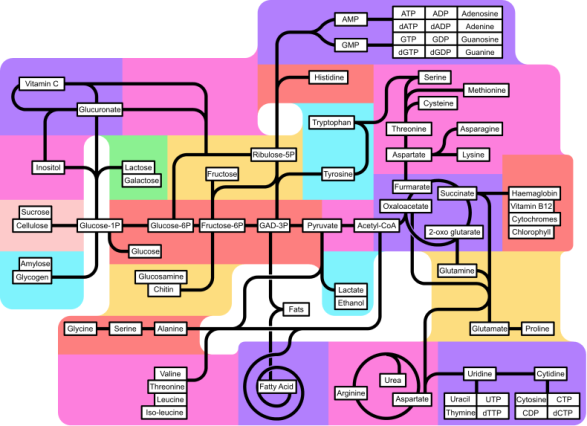Hey Biochem folks,
Glycolisis (Biochemistry) by Pitanja sa kolokvijuma Pomozimo kolegama
http://www.youtube.com/watch?v=kIHkPYLdy8U
Here is another video that is focused on Glycolysis. This was a long video of just over 50 minutes and the content focused on a medical based knowledge. The lecturer kept focus on the essentials towards the general board exams for medical students and touched on the key aspects of the glycolytic pathway as well as physiological and pathophysiological points to link the biochemistry of glycolysis.
This video was quite informative and interesting, even though there was much content that was not applicable to our course. I felt that the lecturer’s explanation was comprehensive and easily understandable. However, there was little animation and pictures where sometimes there were periods of just looking at the same diagram as he spoke, that was a little monotonous. However, the content was excellent and the explanations were clear and concise. All of the information he mentioned in this video, I came about in my reading and preparation for the glycolysis blog posts and therefore, I found that this video was a well-summarized and integrative approach to the topic of glycolysis.
Even though, there was a lot of skipping through the stages of glycolysis, except for the irreversible stages, there was a good summary of each stage and the focus on the three regulatory enzymes as well as how these enzymes were regulated and the implications of their regulation, was very helpful. The lecturer clearly outlined the process, reasoning behind the regulation of the enzyme and the unique characteristics of the liver that facilitates a more dynamic glycolytic pathway.
The video, however, did not go into any detail on the fates of pyruvate but rather brushed through the two main pathways of producing lactic acid or acetyl-CoA. There was a general summary on lactic acid production and the implications on the human body. However, the applications of this knowledge to athletes and their increased conditioning that may overcome the lactic acid production with extraneous, vigorous exercise, was the highlight of that section. This application created a deeper understanding into the reasons for the physiological changes that occur due to exercise. A fascinating point was the importance of 2, 3-BPG to oxygen dissociation and it importance towards oxygen transport to foetuses in pregnant women.
In summary, this video was informative, interesting and easy to understand. Even though, the content was less applicable to our syllabus, it still provided accurate and well-integrated real life information on glycolysis. The lecturer was well articulated and seemed very knowledgeable in this topic. Overall, the video was good and I recommend that you look at it in your spare time. The major points of this video are summarized below, but I would suggest that you look for yourself.
The video begins with the lecturer talking about how glucose enters the cell. Glucose enters the cell through the GLUT transporters, as he mentioned and these transporters are tissue specific and have different Km values. This means that the affinity for glucose to enter different cells is dependent on different circumstances. As he continues, the lecturer mentions that GLUT 1 and 3 transporters are found in most cells and have a low Km of 1 mmol value, which means that glucose is able to diffuse steadily into cells. However, GLUT 2 are found in the liver and pancreas and have a high Km value and follows 1st order kinetics in that the increase in glucose concentration leads to increase diffusion through these transporters in to the cell. He also mentioned about GLUT 4 transporters that are found in skeletal muscle and adipose tissues that are insulin-dependent and so will facilitate glucose uptake in response to insulin release. Interestingly enough, these GLUT 4 transporters also are increased in muscle cells in response to increased exercise. So one may allude to the fact that increased GLUT 4 transporters in muscles means an increased demand for glucose to generate energy is critical to maintain functioning.
As the lecturer proceeds, he goes into depth of the process of glycolysis with the focus on the three irreversible, regulated steps of glycolysis. He mentions the importance of phosphorylation of glucose and the fact that that hexokinase required Mg ions as a co-factor. He also explains that there is another enzyme, glucokinase in the liver that performs this phosphorylation reaction to convert glucose to glucose 6-phosphate. Glucokinase is hormone-dependant and is able to trap all excess glucose in the blood into hepatocytes in response to insulin release. It was determined that hexokinase is inhibited by glucose 6-phosphate and therefore, when there is an accumulation of glucose 6-phosphate, it prevents hexokinase from converting anymore glucose. Therefore, the excess glucose is funnelled to the liver.
Next, the lecturer explains the importance of PFK-1 and how it is regulated. AMP is able to activate this enzyme and therefore increase its action to produce fructose 1, 6-bisphosphate. This is because, increase levels of AMP may occur when there is increase in exercise and hence there is more utilization of energy and so need to increase the rate of glycolysis to generate energy. ATP and citrate inhibit PFK-1 since these are both indicators of high energy states. When PFK-1 is inhibited, there is decrease in glycolysis and hence will not be able to go on to make fatty acids, which is essential to lipid production. Therefore in the liver, PFK-2 is present and produces fructose 2, 6-bisphosphate. This product over-rides ATP inhibition and forces PFK-1 to continue glycolysis in the liver. It is a very potent activator of PFK-1 to ensure that glycolysis ensues in the liver. This is essential to continue to utilize the high glucose levels in the blood. PFK-2 is driven by insulin.
Glucagon is also essential to the liver since there is inhibition of PFK-1 in the liver and decreases glycolysis and increases gluconeogenesis. This is critical for fasting states and resting states. The lecturer then explains the implications of these processes on persons with hyperglycaemia such as diabetics.
The lecture continues to explain some alternative pathways for dihydroxyacteone phosphate. He then goes on to proceed through the different stages in the energy generation phase of glycolysis. There is little focus on most of the stages in this phase by the lecturer except to note that glyceraldehyde 3-phosphate dehydrogenase generates NADH from the only oxidation reaction in the pathway and performs phosphorylation via an inorganic phosphate. There is a very brief explanation about substrate level phosphorylation. He also notes that in rbc, there is also the conversion of 1, 3-BPG to 2, 3-BPG.
The lecturer then focuses on the last stage of glycolysis catalysed by pyruvate kinase. It is noteworthy that phosphoenolpyruvate is the highest energy compound of the cell. PEP has twice the amount of energy of ATP. There was also discussion on the pyruvate kinase deficiency and the pathophysiology of the haemolytic anaemia that occurs from this deficiency. During this discussion, he explains the importance of glycolysis, NADH and NADPH to erythrocytes and why the blood glucose levels must be maintained at 5mmol.
The video continues to explain the production of lactate and the effects on the body as well as the case with athletes being able to intake high percentage of oxygen and therefore will have increased rates of glycolysis and increased rates of energy production through TCA and ETC. The lecturer then ties this concept into the oxygen transportation of rbc and the release of oxygen from haemoglobin and the importance of 2, 3-BPG. There is an explanation of oxygen saturation curve and the role of 2, 3-BPG. The video ends with the description of the physiology of oxygen transport from mother to foetus in pregnancy.
Hope you will enjoy it as much as I did. Until next posting….


